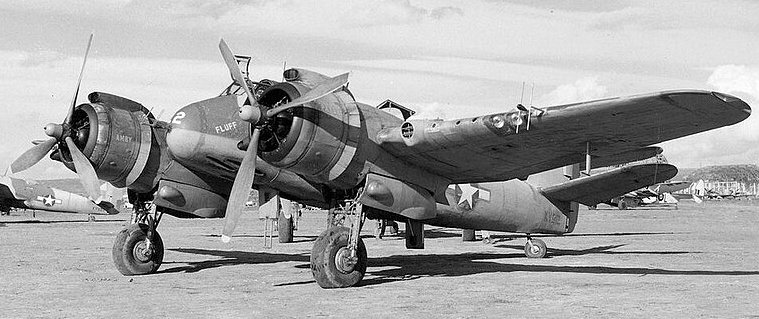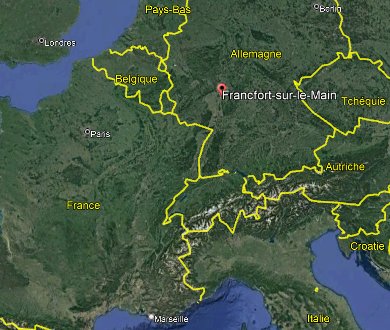ACUFO-1944-12-00-FRANKFURT-1
Ufology sources in the 2010's indicate that author Keith Chester, in his 2007 book “Strange Company - Military Encounters with UFOs in World War II”, reported his correspondence with Warren Rodick, about the latter's sighting in December 1944 between Frankfurt and Karlsruhe, in Germany.
It is said that Lieutenant Owen H. Davis, pilot, and Lieutenant Warren G. Rodick, radar operator, of the 415th Night Fighter Squadron of the US Army Air Forces, were on an intruder mission above Germany, under weather conditions changing from clear to rain to snow. There were no German aircraft in the area and their radar screen was clear. Suddenly, three to four very bright balls of light flew within one hundred feet of their wing. The balls were completely illuminated, of red, yellow, white, and blue colors, and they seemed to be the size of a tennis ball at arm's length. The witnesses could not discern any kind of structure within the shape of the colored lights.
For twelve minutes, the pilot performed evasive action, turning, climbing to higher altitudes, trying to elude the lights, but they remained right with them. The lights were able to keep the same distance from them no matter what kind of maneuver Lieutenant Davis tried. The radar operator felt that they were some kind of markers to track their Beaufighter's height and speed. But no anti-aircraft fire or enemy night fighter attacks came.
The chase finally ended when the lights simply disappeared.
We are told that between December 1944 and January 1945, Warren Rodick had no less than nine sightings.
An earlier source does exist: war correspondent Ed Clark had visited the airmen of the 415th Night Fighter Squadron at the time of these sightings, and wrote an article about the foo-fighters; which appeared in several publications such as in Stars and Stripes magazine, European edition, on February 19, 1945.
Clark told that many of the night fighters airmen who has seen the “foo-fighters” were veterans of the African and Italian campaigns; and he quoted pilot Lieutenant Owen H. Davis, of Saint-Petersburg, Florida, and his navigator, Lieutenant Warren G. Rodick, of New Orleans, saying about the comments by some scientists in the USA who argued that these pilots had seen “spots before their eyes”:
“If we're starting to see things now, we'd better quit and go home.”
| Date: | December 1944 |
|---|---|
| Time: | Probable night. |
| Duration: | 12 minutes. |
| First known report date: | 2007 |
| Reporting delay: | 6 decades. |
| Country: | Germany |
|---|---|
| State/Department: | Hessen |
| City or place: | Frankfurt (Frankfurt-am-Main) |
| Number of alleged witnesses: | 2 |
|---|---|
| Number of known witnesses: | 1 |
| Number of named witnesses: | 2 |
| Reporting channel: | ? |
|---|---|
| Visibility conditions: | Night. |
| UFO observed: | Yes. |
| UFO arrival observed: | Yes. |
| UFO departure observed: | Yes. |
| UFO action: | Follow plane also during escape maneuvers. |
| Witnesses action: | Escape maneuvers in vain. |
| Photographs: | No. |
| Sketch(s) by witness(es): | No. |
| Sketch(es) approved by witness(es): | No. |
| Witness(es) feelings: | ? |
| Witnesses interpretation: | ? |
| Sensors: |
[X] Visual: 2
[ ] Airborne radar: Not reported. [ ] Directional ground radar: Not reported. [ ] Height finder ground radar: [ ] Photo: [ ] Film/video: [ ] EM Effects: [ ] Failures: [ ] Damages: |
|---|---|
| Hynek: | LN |
| Armed / unarmed: | Armed, four 20 mm cannons and six 7,62 mm machines guns. |
| Reliability 1-3: | 2 |
| Strangeness 1-3: | 3 |
| ACUFO: | Possible extraterrestrial craft. |
[Ref. eck1:] ED CLARK - STARS AND STRIPES:
By Ed Clark
Stars and Stripes Staff Writer
WITH THE 1st TACTICAL AlR FORCE. Feb. 18. -- Discussion of the Foo-Fignters, weird thingamajigs spotted by U.S. night fighters over enemy territory, reached a new peak here today as Beaufighter crews received news from home that the Foo-Fighters were figments of the imagination and strictly from the realm of make-believe.
Particularly disgusting to the night fliers who have seen Foo-Fighters off and on for the past four months was a recent article in Time which said “Skeptical scientists, baffled by the whole affair, were inclined to dismiss the fireballs as an illusion, perhaps an image of light which remained in the pilots' eyes after they had been dazzled by flak bursts.”
Nobody, the Beaufighter crew members agreed, was prepared to explain the Foo-Fighters, but they were incensed to learn that the phenomenon had been lightly passed off as a case of spots before their eyes.
Many of these night fighters are veterans of the African and Italian campaigns which lacked the added attraction of Foo-Fighters. As one pilot, Lt. Owen H. Davis, St Petersburg, Fla., and his navigator, Lt. Warren G. Rodick, New Orleans, put it:
“If we're starting to see things now, we'd better quit and go home.”
Without ever having actually met, these Beaufighter men have at least accumulated a passing acquaintance-better than others-with the Foo-Fighters, during their last four months of operation over German territory.
They described them as balls of colored light which rise from the ground in Krautland and move in on the U.S. night fighters shortly after they near or cross the battle lines. Sometimes they are in sets, as many as ten. Their color has ranged from red to orange, yellow, white and even blue.
Playing it safe, no Beaufighter crew has yet allowed the Foo-Fighters to close in, but has always gone into evasive dives and turns while the thingamajigs were still a sure distance off the wing or tail tips
[Ref. dwn2:] DOMINIQUE WEINSTEIN:
Lt Owen H. Davis (pilot) and Lt Warren G. Rodick (radar operator) of the 415th NFS were on an intruder mission above Germany. Weather conditions were changing from clear to rain to snow. There were no German aircraft in the area and their radar screen was clear. Suddenly three to four very bright balls of light flew within one hundred feet of their wing. The balls were completely illuminated. They were red, yellow, white, and blue in color and seemed to be the size of a tennis ball at arm's length. The witnesses could not discern any kind of structure within the shape of the colored lights. For twelve minutes, the pilot performed evasive action, turning, climbing to higher altitudes, trying to elude the lights, but they remained right with them. The lights were able to keep the same distance from them no matter what kind of maneuver Lt Davis tried. The radar operator felt that they were some kind of markers to track their Beaufighter's height and speed. but no antiaircraft fire or enemy night fighter attacks came. The chase finally ended when the lights simply disappeared. Between December 1944 and January 1945, Warren Rodick had no less than nine sightings.
Sources: Correspondence with Warren Rodick by Keith Chester / Strange Company, Keith Chester, 2007.
(Ref. nip1:) "THE NICAP WEBSITE":
(1944) Dec. 1944; Bt. Frankfurt and Karlsrhue [sic], Germany
Three to four very bright balls, completely illuminated red, yellow, white and blue in color; size of tennis ball at arms length. (Page 119 Ref.1)
The reference 1 is described at the end of the document as “Strange Company (2007), Keith Chester”.
[Ref. tai1:] "THINK ABOUT IT" WEBSITE:
Date: Dec. 1944
Location: Bt. Frankfurt and Karlsrhue, Germany
Time:
Summary: Three to four very bright balls, completely illuminated red, yellow, white and blue in color; size of tennis ball at arms length.
Page 119 Ref.1
The Bristol Type 156 “Beaufighter”, nicknamed “Beau”, was a British multi-role aircraft developed during WWII. It was originally conceived as a heavy fighter variant of the Bristol Beaufort torpedo bomber; it proved to be an effective night fighter, which came into service with the Royal Air Force (RAF) during the Battle of Britain.
Originally, armament consisted of four 20mm cannons and six 0.303-in machine-guns but many variants were built; for example, versions had the ability to additionally carry eight rocket projectiles, some had a Vickers 'K' gun, Beaufighter TF.Mk X was used for anti-shipping operations.
The Beaufighter Mk VIF was fitted with the Mark VIII radar.
Below: Beaufighter Mk VIF of the 415th Night Fighter Squadron.

|
The Beaufighters served with the US Army Air Force until the end of the war, but most were replaced by the P-61 “Black Widow” beginning on March 20, 1945.

|
Warren G. Rodick was born in 1921, and lived in New Orleans, Louisiana, USA. He served in the US military from 1938 to 1946.
I was unable so far to find information about Owen H. Davis.
Possible extraterrestrial craft.
* = Source is available to me.
? = Source I am told about but could not get so far. Help needed.
| Main author: | Patrick Gross |
|---|---|
| Contributors: | None |
| Reviewers: | None |
| Editor: | Patrick Gross |
| Version: | Create/changed by: | Date: | Description: |
|---|---|---|---|
| 0.1 | Patrick Gross | November 18, 1944 | Creation, [dwn2], [nip1], [tai1]. |
| 1.0 | Patrick Gross | November 18, 1944 | First published. |